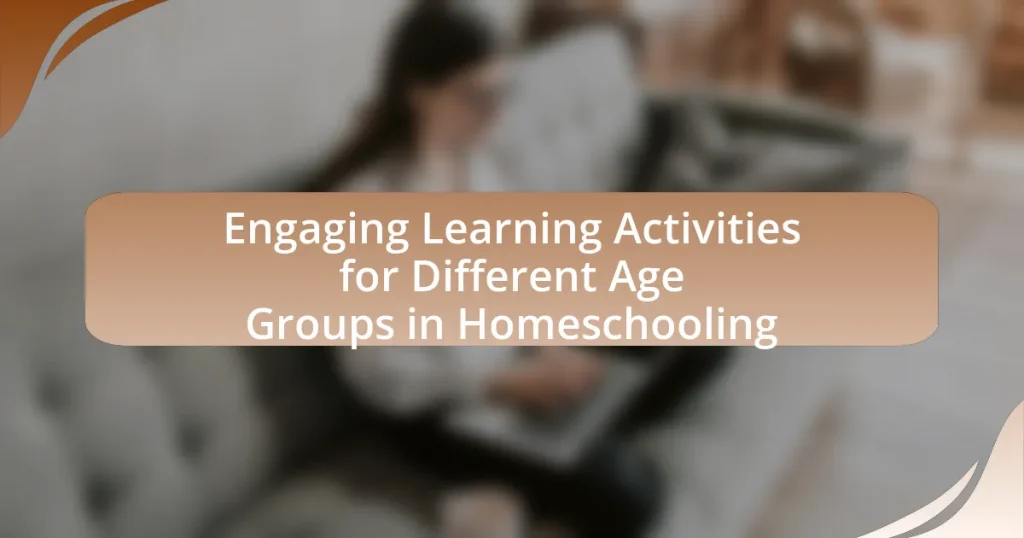The article focuses on engaging learning activities tailored for different age groups in homeschooling, highlighting the importance of age-appropriate methods to enhance educational outcomes. It outlines specific activities for younger children, early readers, middle schoolers, and high school students, emphasizing hands-on experiments, interactive storytelling, project-based learning, and research assignments. The article also discusses how developmental milestones and learning styles vary across age groups, the significance of engagement in learning, and effective strategies for fostering critical thinking and collaboration among older students. Additionally, it provides insights into integrating technology and real-world problems into the learning process to further enrich the educational experience.
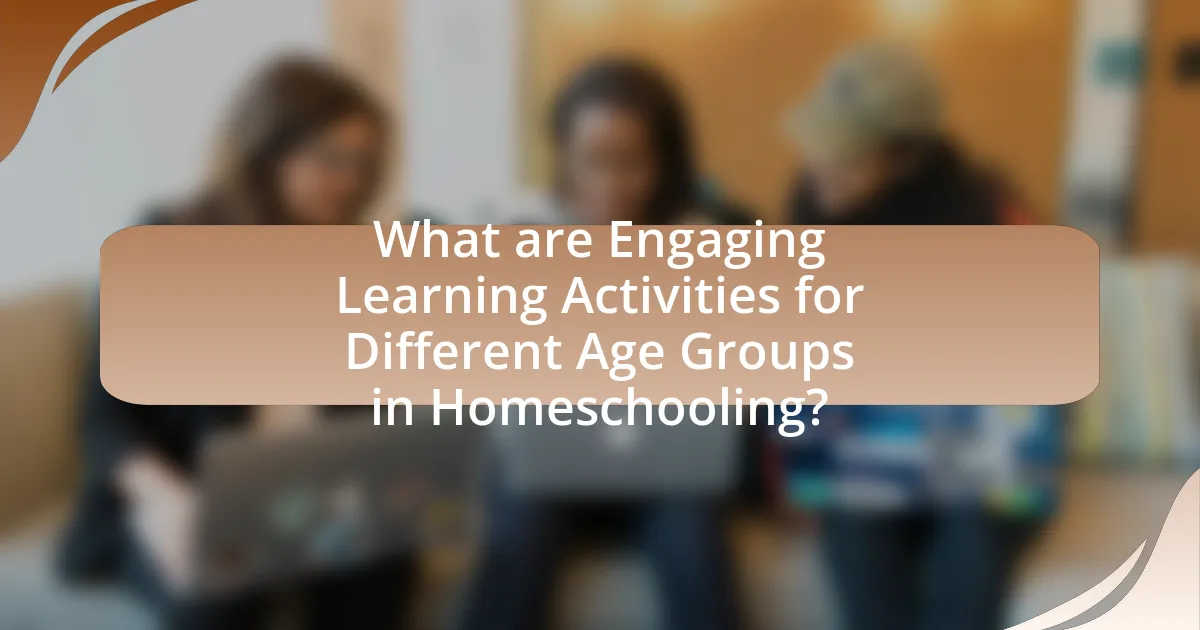
What are Engaging Learning Activities for Different Age Groups in Homeschooling?
Engaging learning activities for different age groups in homeschooling include hands-on experiments for younger children, interactive storytelling for early readers, project-based learning for middle schoolers, and research assignments for high school students. For younger children, activities like building with blocks or nature scavenger hunts promote exploration and creativity. Early readers benefit from interactive storytelling, where they can act out stories or create their own narratives. Middle schoolers engage well with project-based learning, such as science fairs or history presentations, which foster critical thinking and collaboration. High school students can deepen their understanding through research assignments that require them to explore topics in depth, enhancing their analytical skills. These activities are supported by educational research indicating that active participation enhances learning outcomes across various age groups.
How do age groups influence the choice of learning activities?
Age groups significantly influence the choice of learning activities by determining the developmental appropriateness and engagement level of the activities. Younger children, typically aged 3-7, benefit from hands-on, play-based learning activities that promote sensory exploration and motor skills, such as arts and crafts or interactive games. In contrast, children aged 8-12 often engage better with structured activities that incorporate critical thinking and problem-solving, such as science experiments or project-based learning. Adolescents, aged 13-18, tend to prefer activities that foster independence and real-world application, such as internships or community service projects. Research indicates that aligning learning activities with the cognitive and emotional development stages of each age group enhances motivation and retention of knowledge, as supported by developmental theories from Piaget and Vygotsky.
What are the developmental milestones for different age groups?
Developmental milestones vary by age group and are critical indicators of a child’s growth and learning capabilities. For infants (0-12 months), milestones include rolling over, sitting up, and babbling. Toddlers (1-3 years) typically begin walking, using simple words, and engaging in parallel play. Preschoolers (3-5 years) often develop skills such as counting, recognizing letters, and participating in cooperative play. School-age children (6-12 years) usually show improvements in reading, writing, and problem-solving abilities, along with increased social interactions. Adolescents (13-18 years) focus on developing abstract thinking, identity formation, and more complex social relationships. These milestones are supported by research from the Centers for Disease Control and Prevention, which outlines expected developmental progressions for children at various ages.
How can learning styles vary among age groups?
Learning styles vary among age groups primarily due to cognitive development and life experiences. Younger children often benefit from hands-on, experiential learning, as they are typically more engaged through play and interactive activities. In contrast, adolescents and adults tend to favor analytical and abstract thinking, often preferring structured learning environments that emphasize critical thinking and problem-solving. Research indicates that children aged 5-7 are more likely to learn effectively through visual and kinesthetic methods, while older learners, such as those in high school or college, often excel with auditory and reading/writing approaches, as supported by the VARK model of learning styles developed by Fleming and Mills. This model illustrates how different age groups gravitate towards distinct learning modalities, reflecting their developmental stages and educational needs.
Why is engagement important in homeschooling?
Engagement is crucial in homeschooling because it directly influences a child’s motivation and retention of knowledge. When students are actively involved in their learning process, they are more likely to understand and remember the material. Research indicates that engaged learners demonstrate higher academic achievement and improved critical thinking skills. For instance, a study published in the “Journal of Educational Psychology” found that students who participated in interactive learning activities scored significantly higher on assessments compared to those who did not. This highlights that engagement not only enhances the learning experience but also leads to better educational outcomes.
What impact does engagement have on learning outcomes?
Engagement significantly enhances learning outcomes by increasing motivation, retention, and understanding of the material. Research indicates that students who are actively engaged in their learning process demonstrate higher academic performance, as evidenced by a study published in the Journal of Educational Psychology, which found that engaged learners scored 20% higher on assessments compared to their less engaged peers. This correlation between engagement and improved learning outcomes underscores the importance of incorporating interactive and stimulating activities in educational settings, particularly in homeschooling environments.
How can engagement be measured in a homeschooling environment?
Engagement in a homeschooling environment can be measured through various methods such as tracking student participation, assessing learning outcomes, and utilizing feedback mechanisms. For instance, monitoring the frequency and quality of interactions during lessons can provide insights into student interest and involvement. Additionally, standardized assessments can evaluate knowledge retention and application, indicating the effectiveness of the learning activities. Surveys and reflective journals can also capture students’ feelings about their learning experiences, offering qualitative data on engagement levels. These methods collectively provide a comprehensive view of engagement in homeschooling settings.
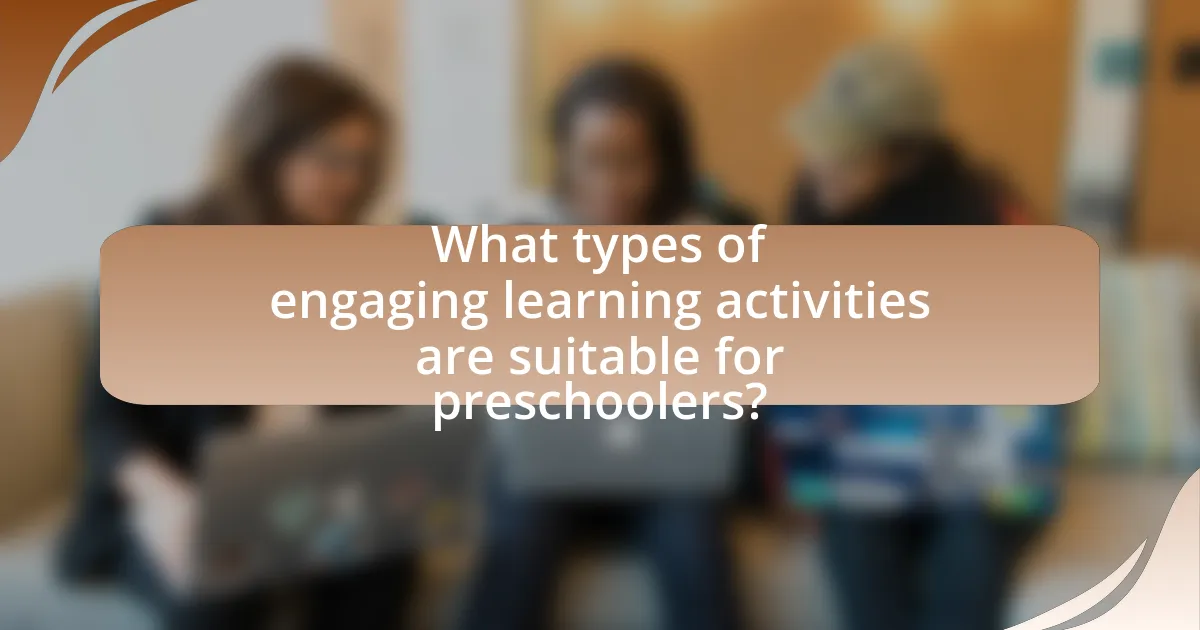
What types of engaging learning activities are suitable for preschoolers?
Engaging learning activities suitable for preschoolers include interactive storytelling, sensory play, and simple art projects. Interactive storytelling enhances language skills and imagination, as children actively participate in the narrative. Sensory play, such as using sand, water, or playdough, promotes fine motor skills and cognitive development through exploration. Simple art projects, like finger painting or collage-making, encourage creativity and self-expression while developing hand-eye coordination. These activities are supported by educational research indicating that hands-on, play-based learning is effective for early childhood development.
How can play-based learning be incorporated for preschoolers?
Play-based learning can be incorporated for preschoolers by integrating structured play activities that promote cognitive, social, and emotional development. Educators and parents can create learning environments that include interactive games, role-playing scenarios, and hands-on activities that align with educational goals. For instance, using building blocks can enhance spatial awareness and problem-solving skills, while storytelling through puppetry can foster language development and creativity. Research indicates that children learn best through play, as it encourages exploration and experimentation, which are crucial for early childhood development.
What are some examples of play-based activities?
Examples of play-based activities include role-playing, building with blocks, and engaging in sensory play. Role-playing allows children to explore different scenarios and develop social skills, while building with blocks enhances spatial awareness and fine motor skills. Sensory play, such as using sand or water, stimulates exploration and creativity, which are essential for cognitive development. These activities are supported by research indicating that play-based learning fosters critical thinking and problem-solving abilities in children, making them effective tools in homeschooling environments.
How do sensory activities enhance learning for preschoolers?
Sensory activities enhance learning for preschoolers by engaging multiple senses, which facilitates cognitive development and retention of information. These activities, such as playing with sand, water, or textured materials, stimulate neural pathways and promote fine motor skills. Research indicates that sensory play can improve language skills, as children describe their experiences and interact with peers, fostering social development. A study published in the journal “Early Childhood Research Quarterly” by researchers at the University of California found that children who participated in sensory-rich environments showed significant improvements in problem-solving abilities and creativity compared to those in less stimulating settings.
What role does storytelling play in preschool education?
Storytelling plays a crucial role in preschool education by enhancing language development, fostering imagination, and promoting social-emotional skills. Through storytelling, children are exposed to new vocabulary and sentence structures, which aids in their linguistic growth. Research indicates that storytelling can improve comprehension and retention of information, as children engage with narratives that capture their interest. Additionally, storytelling encourages creativity and critical thinking, allowing preschoolers to explore different perspectives and emotions. Studies have shown that interactive storytelling, where children participate in the narrative, significantly boosts their engagement and learning outcomes.
How can storytelling be made interactive for preschoolers?
Storytelling can be made interactive for preschoolers by incorporating elements such as puppetry, sound effects, and audience participation. These methods engage young children by allowing them to act out parts of the story, make sound effects, or respond to questions posed by the storyteller. Research indicates that interactive storytelling enhances comprehension and retention, as demonstrated in studies where children who participated in storytelling activities showed improved language skills and engagement levels compared to those who listened passively.
What are the benefits of using stories in learning?
Using stories in learning enhances engagement, retention, and understanding of concepts. Stories create emotional connections, making information more relatable and memorable. Research indicates that narrative-based learning can improve comprehension by up to 70%, as it allows learners to visualize and contextualize information within a framework they can easily grasp. Additionally, stories stimulate critical thinking and creativity, encouraging learners to analyze situations and draw conclusions, which is essential for deeper learning.
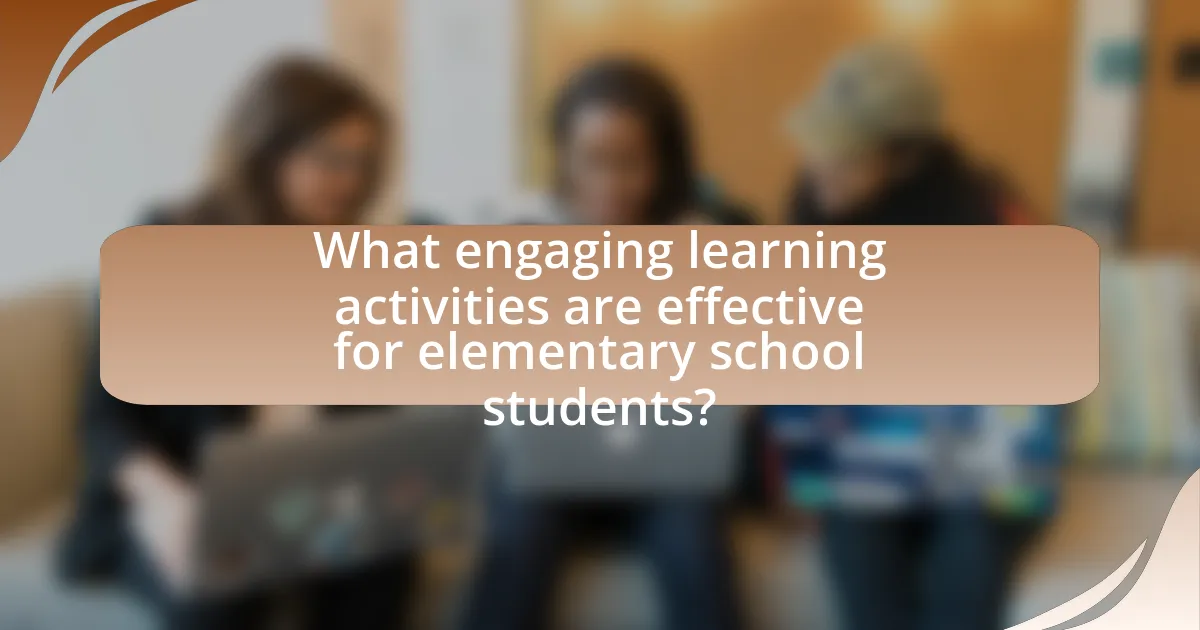
What engaging learning activities are effective for elementary school students?
Effective engaging learning activities for elementary school students include hands-on projects, interactive games, and collaborative group work. Hands-on projects, such as science experiments or art creations, allow students to explore concepts actively, enhancing retention and understanding. Interactive games, like educational board games or digital learning apps, promote engagement through competition and fun, making learning enjoyable. Collaborative group work fosters social skills and teamwork, as students learn to communicate and solve problems together. Research indicates that active learning strategies, including these activities, significantly improve student outcomes in elementary education, as shown in studies published by the National Education Association.
How can hands-on activities enhance learning for elementary students?
Hands-on activities enhance learning for elementary students by promoting active engagement and facilitating experiential learning. These activities allow students to manipulate materials, explore concepts in a tangible way, and apply their knowledge to real-world situations. Research indicates that students who participate in hands-on learning experiences demonstrate improved retention of information and higher levels of motivation. For instance, a study published in the Journal of Educational Psychology found that students engaged in hands-on science experiments scored significantly higher on assessments compared to those who received traditional instruction. This evidence supports the effectiveness of hands-on activities in fostering deeper understanding and retention among elementary learners.
What types of science experiments are suitable for this age group?
Simple science experiments suitable for young children include activities like making a volcano with baking soda and vinegar, creating a rainbow with a glass of water and a flashlight, and growing crystals using sugar or salt. These experiments are age-appropriate as they involve safe, easily accessible materials and encourage hands-on learning. Research shows that engaging in such experiments enhances children’s understanding of basic scientific concepts, promotes curiosity, and develops critical thinking skills. For instance, a study published in the Journal of Science Education found that interactive experiments significantly improve children’s interest in science.
How can art projects be integrated into core subjects?
Art projects can be integrated into core subjects by using them as a medium to explore and reinforce concepts in subjects like math, science, and history. For instance, students can create geometric art to understand shapes and angles in math, or they can design historical timelines using visual art to depict significant events. Research indicates that integrating art into education enhances creativity and critical thinking, which are essential skills across all subjects. A study by the Arts Education Partnership found that students engaged in arts-integrated learning demonstrate improved academic performance and retention of information.
What role does technology play in engaging elementary students?
Technology plays a crucial role in engaging elementary students by providing interactive and personalized learning experiences. It facilitates hands-on activities through educational software and applications that cater to various learning styles, making lessons more appealing. For instance, studies show that using technology in classrooms can increase student motivation and participation, with a report from the International Society for Technology in Education indicating that 75% of teachers believe technology enhances student engagement. Additionally, technology allows for immediate feedback, enabling students to learn at their own pace, which is essential for young learners who may require different levels of support.
What educational apps are recommended for this age group?
Recommended educational apps for this age group include Khan Academy Kids, ABCmouse, and Duolingo. Khan Academy Kids offers a comprehensive curriculum covering subjects like math, reading, and social-emotional learning, making it suitable for early learners. ABCmouse provides a structured learning path with interactive activities across various subjects, enhancing foundational skills. Duolingo focuses on language acquisition through gamified lessons, making it engaging for young learners. These apps are widely recognized for their effectiveness in promoting educational engagement and skill development in homeschooling environments.
How can online resources be effectively utilized?
Online resources can be effectively utilized by integrating interactive tools, educational platforms, and multimedia content tailored to various age groups in homeschooling. For instance, platforms like Khan Academy and Coursera offer age-appropriate courses that enhance learning through structured lessons and assessments. Additionally, utilizing educational games and simulations can engage younger learners, making complex subjects more accessible and enjoyable. Research indicates that interactive learning can improve retention rates by up to 75%, demonstrating the effectiveness of these resources in fostering a deeper understanding of the material.
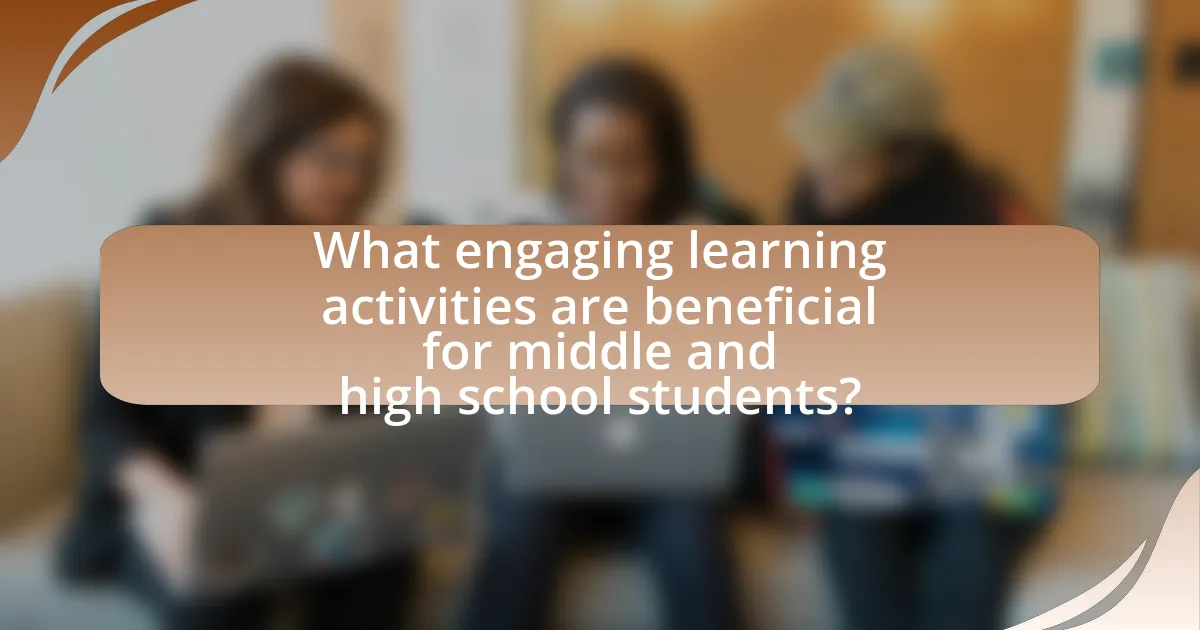
What engaging learning activities are beneficial for middle and high school students?
Engaging learning activities beneficial for middle and high school students include project-based learning, interactive simulations, and collaborative group work. Project-based learning allows students to explore real-world problems, enhancing critical thinking and problem-solving skills. Interactive simulations, such as virtual labs or role-playing scenarios, provide hands-on experiences that deepen understanding of complex concepts. Collaborative group work fosters communication and teamwork, essential skills for future success. Research indicates that these methods improve student engagement and retention of information, making them effective strategies in homeschooling environments.
How can project-based learning be implemented for older students?
Project-based learning can be implemented for older students by designing interdisciplinary projects that align with their interests and real-world applications. Educators can facilitate this by allowing students to choose topics that resonate with them, encouraging collaboration in small groups, and integrating technology for research and presentation. Research shows that project-based learning enhances critical thinking and problem-solving skills, as evidenced by a study from the Buck Institute for Education, which found that students engaged in project-based learning demonstrated higher retention of knowledge and improved engagement compared to traditional learning methods.
What are some examples of interdisciplinary projects?
Examples of interdisciplinary projects include the “Water Quality Monitoring” project, where students combine science, technology, and mathematics to assess local water sources, and the “Cultural Heritage Fair,” which integrates history, art, and language studies as students research and present on various cultures. Another example is the “Sustainable Garden” initiative, where biology, environmental science, and economics intersect as students learn about ecosystems, plant growth, and the financial aspects of gardening. These projects demonstrate the effectiveness of combining multiple disciplines to enhance learning outcomes in homeschooling environments.
How can community service projects enhance learning?
Community service projects enhance learning by providing practical, real-world experiences that reinforce academic concepts. Engaging in these projects allows learners to apply theoretical knowledge in meaningful contexts, fostering critical thinking and problem-solving skills. Research indicates that students involved in service-learning demonstrate higher academic achievement, improved engagement, and enhanced social skills. For instance, a study published in the “Journal of Experiential Education” by Eyler and Giles found that service-learning participants showed significant gains in academic performance compared to their peers. This evidence underscores the effectiveness of community service projects in enriching the educational experience.
What strategies can be used to foster critical thinking in older students?
To foster critical thinking in older students, educators can implement strategies such as Socratic questioning, project-based learning, and collaborative discussions. Socratic questioning encourages students to think deeply by challenging assumptions and exploring different perspectives, which has been shown to enhance analytical skills. Project-based learning allows students to engage in real-world problems, promoting inquiry and problem-solving abilities, as evidenced by research from the Buck Institute for Education, which highlights improved critical thinking outcomes in students involved in such projects. Collaborative discussions facilitate peer-to-peer learning, where students articulate their thoughts and critique each other’s ideas, further developing their reasoning and evaluative skills.
How can debates and discussions be structured effectively?
Debates and discussions can be structured effectively by establishing clear rules, defining roles, and ensuring a balanced representation of viewpoints. Clear rules provide a framework for respectful dialogue, while defined roles, such as moderator and participants, help maintain order and focus. Balanced representation ensures that all sides of an argument are heard, fostering critical thinking and engagement among participants. Research indicates that structured formats, like the Socratic method, enhance understanding and retention of information, making discussions more productive.
What role do real-world problems play in engaging older students?
Real-world problems play a crucial role in engaging older students by providing relevant and relatable contexts for learning. When students encounter practical issues, they are more likely to see the value in their education, as it connects theoretical knowledge to everyday life. Research indicates that problem-based learning, which often involves real-world scenarios, enhances critical thinking and problem-solving skills, making learning more meaningful. For instance, a study published in the Journal of Educational Psychology found that students who engaged with real-world problems demonstrated higher levels of motivation and retention of information compared to those who learned through traditional methods. This engagement fosters a deeper understanding of subject matter and encourages students to take ownership of their learning.
What are some best practices for creating engaging learning activities across age groups?
To create engaging learning activities across age groups, it is essential to incorporate a variety of teaching methods that cater to different learning styles. Utilizing hands-on activities, such as experiments or art projects, can enhance engagement for younger learners, while discussions and problem-solving tasks can be more effective for older students. Research indicates that active learning strategies, which involve students in the process, lead to better retention and understanding of material. For instance, a study published in the Journal of Educational Psychology found that students who participated in interactive learning activities scored significantly higher on assessments compared to those who engaged in traditional lecture-based learning. Additionally, incorporating technology, such as educational apps and online resources, can appeal to a wide range of ages and interests, making learning more dynamic and accessible.










